CuriosityRover
Latest

Broken wheels won't stop Curiosity from exploring Mars
NASA's Curiosity Rover has been roaming around Mars for more than five years. In that time, it's sent back a ton of data about the red planet. Thanks to the robot, we know that the veins dotted around its craters were likely created by evaporating lakes. It also spotted more water evidence in possible mud cracks. And, its findings led scientists to theorize that ancient Mars had a lot more oxygen that they initially thought. But, all that riding around hasn't been easy on the car-sized machine. In the past, it's suffered a software scare here and there. This time round, its wheels are the problem.
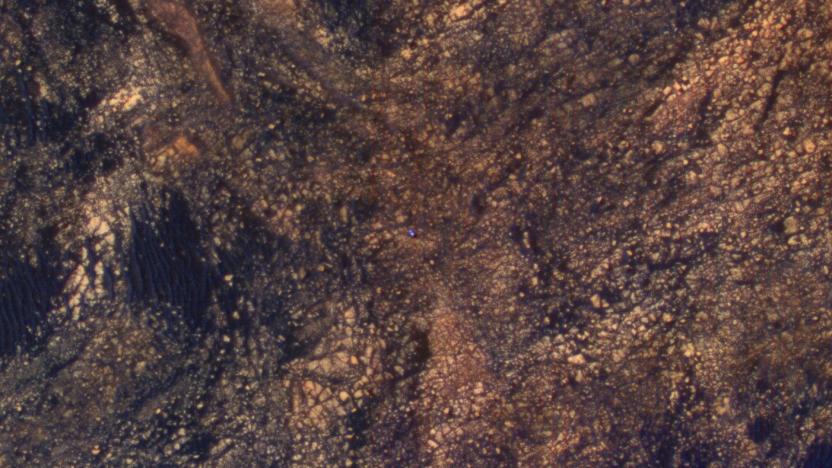
NASA's Curiosity rover is just a speck in this orbiter photo
At this distance, Curiosity looks like a tiny beetle crawling over volcanic rock. Electric blue, its protective shell stands out against the rough, jagged mountainside. In reality, this is an image shot by NASA's Mars Reconnaissance Orbiter, an observational craft floating 200 miles above the planet's surface. We have, of course, seen Curiosity countless times before — it has a thing for selfies — but rarely from afar. In this photograph, you get a real sense of the planet's natural beauty and how empty, or quiet it must seem compared to Earth. Not that Curiosity minds, of course.
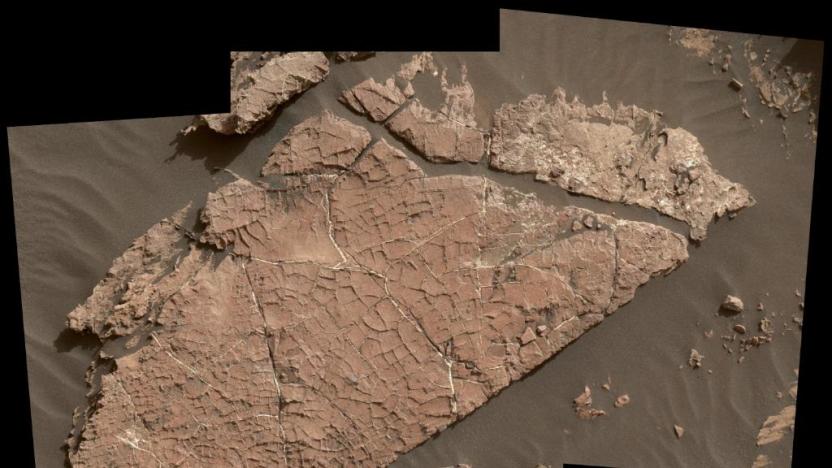
NASA's Curiosity finds new water evidence in possible cracked mud
NASA's four-year-old Curiosity rover spent 2016 discovering new clues to Mars' history, including veins potentially from evaporated lakes and mineral deposits suggesting the planet once had oxygen. The craft spent the beginning of 2017 examining a newly-discovered natural formation: Rock cross-cut with ridges, which are probably mud cracks.

Curiosity rover sends back stunning pics from Martian mountains
NASA's Mars Curiosity rover may have taken a little break earlier this summer, but the craft has been back at work and beamed some excellent images back to Earth late last week. Curiosity has been exploring the "Murray Buttes" region of Mount Sharp and send back color photos of what NASA Curiosity Project Scientist Ashwin Vasavada called "[a] road trip through a bit of the American desert Southwest on Mars." Indeed, these large color photos are evocative of what you might see down in Arizona or New Mexico.
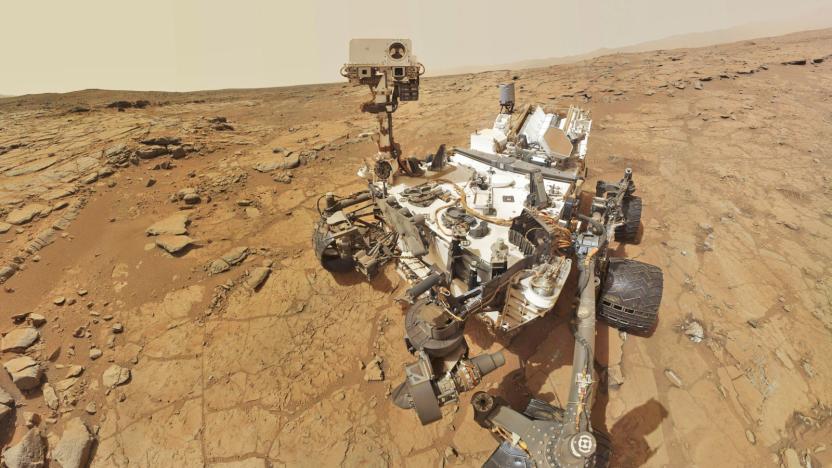
Curiosity rover can shoot lasers at any rock it wants
Is there anything cooler than sending a robot to Mars to shoot rocks with lasers? Probably not -- which is why NASA is giving the Curiosity rover the ability to shoot even more rocks with lasers. Okay, technically NASA is giving the Martian rover the ability to choose targets for ChemCam analysis. This is a process that uses a laser and telescopic camera to sort out the chemical composition of Martian rocks. Typically, NASA chooses the targets manually, but a new update will allow the rover to collect data autonomously.
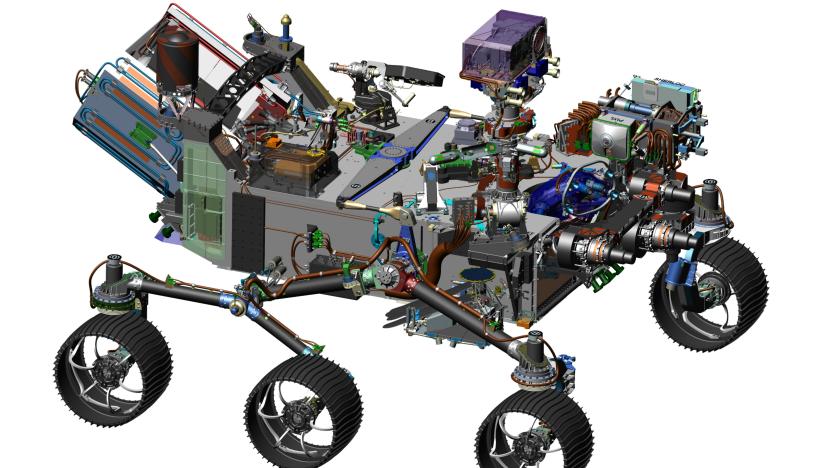
NASA's Mars 2020 rover will search for signs of past life
After building out its next Mars rover in mixed-reality simulations, NASA is ready to announce the near-final design that will depart for the red planet in the summer of 2020. Unlike Curiosity, which is still on its extended tour, the Mars 2020 rover will investigate an area of the planet searching for evidence of past life, with a long-term goal to carefully collect samples of Martian rocks and return them to Earth for further analysis.
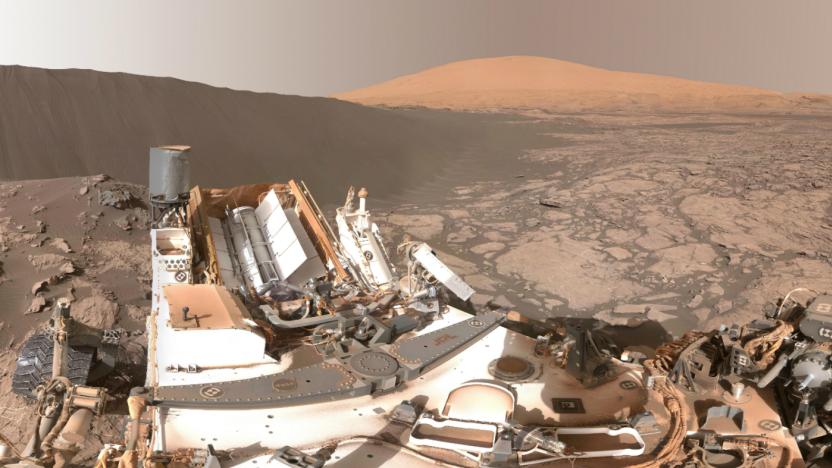
NASA's Curiosity offers another 360-degree peek at Mars
Less than two weeks ago NASA posted a 360-degree video on Facebook that showed the perspective of its Curiosity rover on Mars. It was an exhilarating view, but the way it had been created -- by stitching together lots of different photographs -- meant the final video offered a strange, fishbowl-like picture. Thankfully, NASA's Jet Propulsion Laboratory has uploaded a replacement to YouTube which is lightyears better than the original. While it's still a static shot -- so more of a panorama than a true 360-degree video -- it's another mesmerizing look at the Red Planet. The component images were captured by Curiosity on December 18, 2015 using the Mast Camera rig, otherwise known as Mastcam, which sits on top of the robot's vertical arm. In the video you can see the Namib Dune, which forms part of the Bagnold Dunes dotted along the northwestern flank of Mount Sharp. NASA notes that, after analysing images taken from orbit, scientists believe the dunes can move as much as one meter during a normal Earth year. A portion of Mount Sharp can be seen on the horizon and of course, Curiosity itself is visible down below on the surface. You can watch the video in your browser and click around to change the perspective, but for an immersive experience we recommend using the YouTube app on your phone or a Google Cardboard -- with the gyroscope sensor you can look around naturally, which is always pretty fun.

Mars Curiosity rover gets into VR with a Facebook 360 video
NASA has posted a Facebook 360 video taken by the Mars Curiosity rover from the surface of Mars that Mark Zuckerberg himself re-posted and called "neat." (A one ton, nuclear buggy takes takes a panoramic video from Mars that you can view in a VR headset, and all you got is "neat?" Get a thesaurus, Mark!) Zuckerberg added that the video was stitched together by Facebook's 360 degree video team, and is made up of 57 separate stills -- in fact, it's more like a panorama than a video. The images were snapped by the rover's robotic arm-mounted Mars Hand Lens Imager (MAHLI) on the northwestern flank of Mount Sharp, and show the steep Namib sand dunes.

Now you can drive around Mars with NASA's Curiosity simulator
Want to explore the surface of the red planet without signing up for the Mars One mission? No problem: NASA has built two interactive web applications that will let you explore the planet to your heart's content from the comfort of your armchair.

NASA patched Curiosity rover's autofocus problem over the air
Pardon me while I say something that might not be entirely popular: Software updates are pretty awesome. Maybe not so much for game consoles, but, I digress because the Curiosity rover recently received a patch that improved the autofocus of its "ChemCam" telescope. Over the air. On Mars. Before the update, scientists at Los Alamos National Laboratory would take nine pictures of a subject (each at a different focus) to get one usable close-up image of any of the Red Planet's rocks and soils, and send them back home. Same goes for any sample analyses the laser was doing. The problem is that for those analyses to be anywhere remotely useful, the telescope projecting said laser needs to be in focus and the workaround in place wasn't very efficient.

NASA panel says Curiosity needs to drive less and drill more
NASA is not getting its money's worth of Curiosity, according to a review panel looking at seven planetary missions. The senior scientists criticized the nuclear-powered Mars rover, saying it needed to take more than the eight drill samples scheduled for the rest of its mission. It added that Curiosity has done too much driving (which has severely damaged the wheels) and peripheral activities like searching for clouds. As a result, it rated the rover lowest of the seven missions reviewed, despite the fact that it cost the most. Meanwhile, the Jupiter Cassini mission, which has produced a spectacular cache of images and scientific data, received the highest rating and will be extended at least three years. Despite the ranking, Curiosity was still graded "very good" and all seven missions will retain their funding. That includes the indefatigable Opportunity rover, still trucking after a decade.

Life on Mars cast into doubt as Curiosity fails to find methane
[Click] Hi, is that David Bowie? [Silence] ... It's NASA here. We've got some news. While it's not a conclusive answer, the Curiosity Rover wasn't able to detect any traces of methane in the Gale Crater. Presence of the gas is one of the things that we were hoping would support our theories about life on Mars, so this comes as a bit of a blow. Now, there *are* terrestrial microbes that don't generate methane, so it's not as if this is a firm "no," but it's not looking anywhere near as likely as it was before. So, uh, does that help at all? [Silence] ... Uh, well, thanks. Bye! [Click]

Watch the Curiosity rover explore Mars in one minute (video)
It hasn't even been a year from the time NASA's Curiosity rover landed on Mars, yet it already boasts a number of accomplishments. All the while, Opportunity's successor has been sending images back to Earth documenting its numerous great deeds, and a fan of the rover's work has compiled many of the them into the video you can find after the break. So, now you can get a glimpse of Curiosity capturing awe-inspiring shots of Mount Sharp, unearthing evidence of liquid water, determining the alien soil's chemical composition, and discovering conditions that could've allowed microbes to thrive on the red planet, all in the span of a minute. Hit play to check out what Curiosity's been up to from its first through its 281st Sol -- or Martian day -- as well as to see the extraterrestrial lands our grandchildren might occupy in the future.

NASA Jet Propulsion Laboratory's Tom Rivellini backstage at Expand (video)
If you truly were terrified during the Seven Minutes of Terror that saw the Curiosity Rover successfully land on Mars, you can blame NASA Jet Propulsion Laboratory's Tom Rivellini. As JPL's Principal Engineer for Entry Descent and Landing Systems, Rivellini co-invented the sky crane landing system that helped the rover plant its wheels on the red planet. He met with us backstage to discuss the challenges that have been encountered with these feats of engineering, and what he's currently working on: a new parachute and heat shield system for landing spacecraft carrying humans or larger rovers on Mars. Hit the jump for the full interview on video. Follow all of Engadget's Expand coverage live from San Francisco right here!

Curiosity rover finds conditions on Mars that could have supported living microbes
"A fundamental question for this mission is whether Mars could have supported a habitable environment," says lead Mars Exploration Program scientist Michael Meyer, quoted in a NASA press release today. "From what we know now, the answer is yes." He's referring to the latest Curiosity findings announced at a press conference today, which NASA says "shows ancient Mars could have supported living microbes." That evidence specifically comes from powder the Curiosity rover drilled out of a rock near an ancient stream bed in Mars' Gale Crater, which contained sulfur, nitrogen, hydrogen, oxygen, phosphorus and carbon -- "some of the key chemical ingredients for life," as NASA puts it. Mars Science Laboratory scientist John Grotzinger further explains that "we have characterized a very ancient, but strangely new 'gray Mars' where conditions once were favorable for life," adding, "Curiosity is on a mission of discovery and exploration, and as a team we feel there are many more exciting discoveries ahead of us in the months and years to come." You can find the full announcement after the break.

Curiosity rover drills into Martian rock, looks for more evidence of water
NASA scientists won't have to wait until InSight's 2016 drilling mission to see what lies beneath the surface of Mars -- Curiosity is already on the case. After developing a taste for Martian soil late last year, the intrepid rover has started exploring the red planet's bedrock, drilling a 0.63 inch (1.6 cm) wide hole 2.5 inches (6.4 cm) deep into Mars' surface. Curiosity will spend the next several days analyzing the resulting powder in hopes of finding evidence of a once-wet planet. The shallow hole marks the first drilling operation ever carried out on Mars, and getting there wasn't easy. "Building a tool to interact forcefully with unpredictable rocks on Mars required an ambitious development and testing program," explained Louise Jandura, the chief engineer of the rover's sample system. "To get to the point of making this hole in a rock on Mars we made eight drills and bored more than 1,200 holes in 20 types of rock on Earth." The Rover tested its drill by creating a shallower hole earlier this month, though samples will only be used from the second, deeper cavity. Check out the source link for more images of the operation, including an animated GIF of the drill in action.

Visualized: Curiosity rover's self-portrait
No, Disney isn't working on Wall-E the live action movie. Pictured above is a self-portrait of NASA's Curiosity rover resting in the Gale crater of Mars. Showcasing some extreme detail, this high-res photo was captured by the Red Planet roller's Mars Hand Lens Imager (MAHLI), with its native image clocking in at 5,463 x 7,595 pixels. The picture's Martian backdrop consists of a trail of freshly made tire tracks with a glimpse of Curiosity's future destination Mount Sharp hanging out in the distance. If you gaze deeply into the unmanned craft's soulless robotic eye, you'll catch a reflection of Mars staring right back at you. To get a closer look at our favorite Martian in all of its uncompressed glory, you can snag the 125MB image file from the second source link below. [Image credit: NASA/JPL-Caltech/Malin Space Science Systems]

NASA's Curiosity rover checks in on Foursquare, gives Mars its first mayor
Yes, seriously. NASA announced on Wednesday that its Curiosity rover had "checked in" on Mars via Foursquare. Marking the first check in from another world, the robotic rover will utilize the location-minded social network to share updates and pictures while visiting the Red Planet. While Curiosity will continue to explore the possibilities of Mars being able to sustain life, it would appear that the fourth planet from the sun just got a brand new mayor. Something tells us the universe's rarest badge is about to be bestowed.

NASA's Curiosity rover finds ancient streambed on Mars, evidence of 'vigorous' water flow
Curiosity may have spent a while limbering up for the mission ahead, but now it's found evidence of an ancient streambed on Mars that once had "vigorous" water flow. Photos of two rock outcroppings taken by the rover's mast camera between the north rim of Gale Crater and the foot of Mount Sharp reveal gravel embedded into a layer of conglomerate rock. The shape of the small stones indicate to NASA JPL scientists that they were previously moved, and their size (think from grains of sand to golf balls) are a telltale sign that water did the work instead of wind. Evidence of H2O on Mars has been spotted before, but this is the first direct look at the composition of riverbeds NASA has observed from above. According to Curiosity science co-investigator William Dietrich, it's estimated that water flowed at the site anywhere from thousands to millions of years ago, moved at a clip of roughly 3 feet per second and was somewhere between ankle and hip deep. "A long-flowing stream can be a habitable environment," Mars Science Laboratory Project Scientist John Grotzinger said. "It is not our top choice as an environment for preservation of organics, though. We're still going to Mount Sharp, but this is insurance that we have already found our first potentially habitable environment."

Curiosity rover starts light robotic arm workout in preparation for scientific main event
As NASA promised, Curiosity has stopped at the quarter pole toward its first scientific destination to test its robotic arm and attached scientific instruments. After 100 yards of driving, the rover extended its 7-foot limb, and will now spend six to ten days checking its predetermined positions and range of motion. That will ensure the appendage is ready after surviving the chilly vaccuum of space and subsequent setdown, and will let its minders see how it functions in the unfamiliar Martian gravity and temperatures. The JPL scientists in charge of the six-wheeler will also peep the Mars Hand Lens Imager and made-in-Canada Alpha Particle X-Ray Spectrometer to warrant that they're up for all the geology to come. If all goes well, the rover will start scooping, drilling and analyzing in earnest when it hits Glenelg, then Mount Sharp -- so, we'd limber up first before tackling all that, too.











